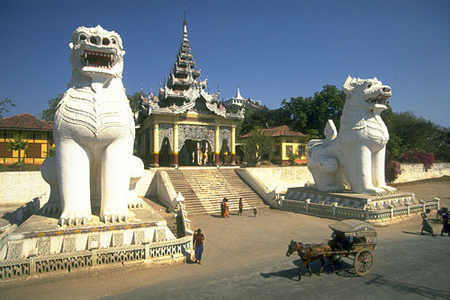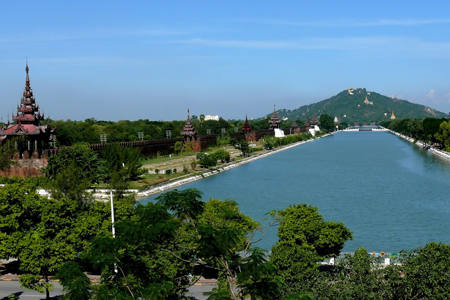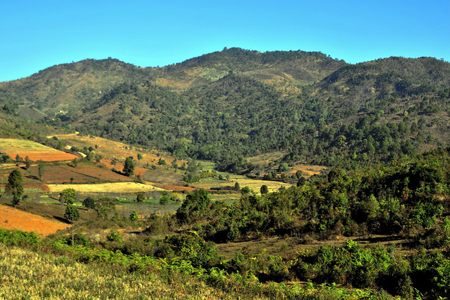About 716 km from Yangon, Mandalay is the second largest city in the country that is slowly attracting many visitors to take an excursion from their trip to Myanmar. The Tale of Mandalay is a tale of two cities in the one-the city that 70 years ago was the capital of, as it turned out, the last King of the last Burmese Dynasty and the city which is now inevitably putting on a mantle of modernity. It is a city that understandably hugs its past, even, to a great extent, lives in the past, and reluctantly, and certainly not very enthusiastically, accepts the irrevocably lost status of the first city of Burma. On the day King Thibaw was forced to surrender to General Prendergast, and put on a ship to be driven into exile in India, old Mandalay wept and, more or less, died. Even today, you have some octogenarians and nonagenarians, who knew King Mindon and King Thibaw (the penultimate and the last Kings of the Alaungpaya Dynasty and of Burma), who worked in the palace in some capacity or the other and whose eyes fill with tears when they think of the city that was. To such, who still carries a heavy heart with them, Rangoon is an impertinence.

Mandalay can never again recapture its old pre-eminence, but as the center of Burmese culture it was outstanding in the past, it holds the stage now, and will continue to have a pride of place in the future. The old lure and the old magic still persist and draw tourists attentions in their Mandalay tours.
Mandalay and anything of interest in Mandalay date from the middle of the 19th century, unlike Pagan, ten centuries old. Mandalay is the most Burmese city in Burma. If you want to hear the best Burmese spoken, it is to Mandalay that you have to turn. It is the home and guardian of the best traditions of Burmese music and dance. A member of the Buddhist clerical order, who has not had the benefit of the study of Buddhist scriptures under a famous Sayadaw -Abbot - of the many famous monasteries of Mandalay, would feel that his education was incomplete.
Mandalay might, and certainly does, think of its departed glories and its loss of prestige in a heart-broken way, but it is proud of being the fountain-head of Burma’s spiritual life. Mandalay is nothing without its Buddhism, its thousands of phongyis - the yellow-clad members of the Buddhist clergy - its monasteries and its famous pagodas. Rangoon may be many things, but Mandalay is Burma’s cultural heart-center.
King Mindon, though dead, lives in Mandalay. In a manner of speaking, because of the ineffaceable impress he has left on it, Mandalay is King Mindon’s city. All that is left of its palace are the windowed walls, the moat around them and a few tombs inside, but round the 954- feet high Mandalay Hill, King Mindon’s spirit still lives. As you move about, every foot of ground round about the Hill forcibly reminds you of King Mindon, what with the monasteries, the pagodas and so on that he sponsored.

There is a colossal standing image of the Buddha on top of the Mandalay Hill, with the right hand outstretched and a finger pointing to where the former palace grounds lie below. The local tradition is that the Buddha himself while on a visit, accompanied by his disciple, Ananda, prophesied that in the 2400th year of the propagation of his Faith, a city would rise which would be hailed as an outstanding center of Buddhism. It was actually in that year, synchronizing with the year 1857, that King Mindon planned the building of the new capital at Mandalay. (The foundation was dug in 1857, the capital formally inaugurated in 1859 and the actual transfer of the government from nearby Amarapura made in 1860). The prophecy going with the Mandalay Hill is believed to have been: “ He who wishes to live long should seek the shelter of the Mandalay Hill which is crossed by the green waters of the Emerald Nanda Lake This prophecy, traditionally handed down, the natural desire for the fame and the name that go with the founding of a new capital, the hereditary impulse that motivated many a new Burmese king in founding a new capital and also the disfavor and even disrepute into which Amarapura had fallen because of the not all-too- creditable reign of his elder brother, Pagan Min - all these must have worked in the mind of King Mindon when Amarapura was discarded and Mandalay was chosen as the new capital.
Mandalay is a rich city, that is, rich in historical memories as the last capital before the British annexed the whole country and also rich in monuments relating to Buddhism, perhaps, the richest next to Pagan.
Mandalay covers an area of 25 square miles and houses a population of 1,225,553. With a rainfall of not more than 30 inches, it is rather a dry place in a wet country. Practically, a third of the city was destroyed during World War II and the principal offensive against the Japanese was centered in and around the Mandalay Hill. War- devastated cities can be rebuilt, but the loss incurred by Mandalay in the destruction of the wooden palace must be said to be irreparable and profound. All Burmese wooden palaces and palace cities conformed to a set pattern and when the capital was shifted, the palace and the city were literally uprooted, wholesale. And the only surviving example of this type of architecture, which Burma had, with magnificent wood-carving embellishing it all, was destroyed, creating a definite and painful void. Mandalay lost a little of its soul and certainly a good bit of its glory, a monument of historical value and, certainly, a star tourist attraction when the palace was bombed out. All that there is now is a model of the palace designed and maintained by the Archaeological Department, in a covered shed on the former palace grounds - a poor and ineffectual aid to an imaginative reconstruction of the palace as it stood.
Seen from the air before you touch down, you will see Mandalay as a near-perfect geometrical pattern, the roads cutting at right angles—physically, a well-laid-out city. The long and broad streets running east-west are, curiously enough, alphabetically named, A, B, C, D, etc. and the cross-streets running north-south numerically, in the American way. Mandalay has not the fast tempo of Rangoon and life is more leisurely, but its quiet ways add to its enchantment. Towards the east, there are the blue Shan Hills which give the city a physical dignity and to the west there is Burma’s life-stream, the mighty Irrawaddy, flowing by.

At Mandalay’s famed Zegyo Bazaar, designed in 1903 by Italian Count Caldrari, the first Secretary of the Mandalay Municipality, colorfully displaying all sorts of wares - this is where you can buy Burmese silks - you will find the colorfully and distinctively dressed hill people from the Shan States, nomadic Tibetan traders, Yunanese from Bhamo, Myitkyina and Lashio and Kachins and Palaungs and so on.
The splendor of the sunset in Mandalay, rendered a little weird by the dust haze, will hold you in its spell.
